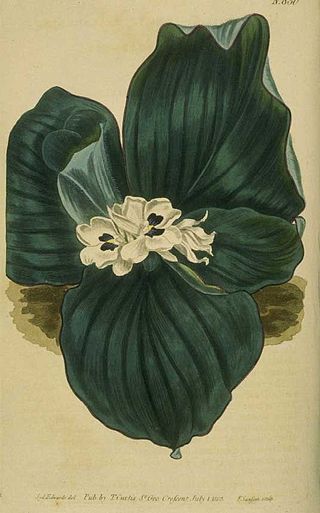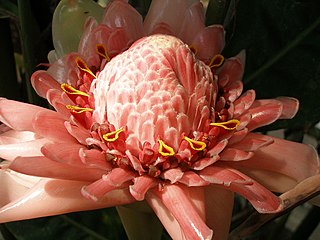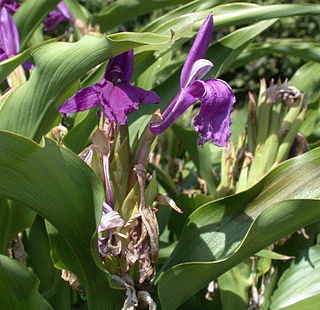
Zingiberaceae or the ginger family is a family of flowering plants made up of about 50 genera with a total of about 1600 known species of aromatic perennial herbs with creeping horizontal or tuberous rhizomes distributed throughout tropical Africa, Asia, and the Americas. Many of the family's species are important ornamental, spice, or medicinal plants. Ornamental genera include the shell gingers (Alpinia), Siam or summer tulip, Globba, ginger lily (Hedychium), Kaempferia, torch-ginger Etlingera elatior, Renealmia, and ginger (Zingiber). Spices include ginger (Zingiber), galangal or Thai ginger, melegueta pepper, myoga, korarima, turmeric (Curcuma), and cardamom.

Ginger is a flowering plant whose rhizome, ginger root or ginger, is widely used as a spice and a folk medicine. It is a herbaceous perennial which grows annual pseudostems about one meter tall, bearing narrow leaf blades. The inflorescences bear flowers having pale yellow petals with purple edges, and arise directly from the rhizome on separate shoots.

Galangal is a common name for several tropical rhizomatous spices.

Boesenbergia rotunda, commonly known as Chinese keys, fingerroot, lesser galangal or Chinese ginger, is a medicinal and culinary herb from China and Southeast Asia. In English, the root has traditionally been called fingerroot, because the shape of the rhizome resembles that of fingers growing out of a center piece.
Wild ginger may refer to any of a variety of plants, often with a similar appearance, odour or taste to cultivated ginger. Species involved include:

Root vegetables are underground plant parts eaten by humans as food. In agricultural and culinary terminology, the term applies to true roots such as taproots and tuberous roots as well as non-roots such as bulbs, corms, rhizomes, and stem tubers.

Alpinia is a genus of flowering plants in the ginger family, Zingiberaceae. Species are native to Asia, Australia, and the Pacific Islands, where they occur in tropical and subtropical climates. Several species are cultivated as ornamental plants.

Alpinia zerumbet, commonly known as shell ginger among other names, is a perennial species of ginger native to East Asia. The plants can grow up to 2.5 to 3 meters tall and bear colorful funnel-shaped flowers. They are grown as ornamentals and their leaves are used in cuisine and traditional medicine.

Eucalyptol is a monoterpenoid colorless liquid, and a bicyclic ether. It has a fresh camphor-like odor and a spicy, cooling taste. It is insoluble in water, but miscible with organic solvents. Eucalyptol makes up about 70–90% of eucalyptus oil. Eucalyptol forms crystalline adducts with hydrohalic acids, o-cresol, resorcinol, and phosphoric acid. Formation of these adducts is useful for purification.

Notocrypta curvifascia, the restricted demon, is a butterfly belonging to the family Hesperiidae. N. curvifascia is commonly found in many regions of temperate and tropical East Asia, Indonesia, and the Indian subcontinent.

Etlingera elatior is a species of herbaceous perennial plant in the family Zingiberaceae; it is native to Indonesia, Thailand, Malaysia and New Guinea.

Alpinia galanga, a plant in the ginger family, bears a rhizome used largely as an herb in Unani medicine and as a spice in Arab cuisine and Southeast Asian cookery. It is one of four plants known as "galangal". Its common names include greater galangal, lengkuas, and blue ginger.

Jamu is a traditional medicine from Indonesia. It is predominantly a herbal medicine made from natural materials, such as roots, bark, flowers, seeds, leaves and fruits. Materials acquired from animals, such as honey, royal jelly, milk and native chicken eggs are often used as well.

Alpinia officinarum, known as lesser galangal, is a plant in the ginger family, cultivated in Southeast Asia. It originated in China, where its name ultimately derives. It can grow 1.5 to 2 m high, with long leaves and reddish-white flowers. The rhizomes, known as galangal, are valued for their sweet spicy flavor and aromatic scent. These are used throughout Asia in curries and perfumes, and were previously used widely in Europe. They are also used as a herbal remedy.

Kaempferia galanga, commonly known as kencur, aromatic ginger, sand ginger, cutcherry, is a monocotyledonous plant in the ginger family, and one of four plants called galangal. It is found primarily in open areas in Indonesia, southern China, Taiwan, Cambodia, and India, but is also widely cultivated throughout Southeast Asia.

Roscoea auriculata is a perennial herbaceous plant occurring in the eastern Himalayas, in Tibet, Bhutan, Nepal and Sikkim. Most members of the ginger family (Zingiberaceae), to which it belongs, are tropical, but R. auriculata, like other species of Roscoea, grows in much colder mountainous regions. It is sometimes grown as an ornamental plant in gardens.
The following outline is provided as an overview of and topical guide to herbs and spices:

Zingiberoideae is a subfamily of plants in the family Zingiberaceae.
Rosemary Margaret Smith (1933–2004) was a Scottish botanist and illustrator who specialized in the taxonomy of the Zingiberaceae, or ginger family. Many of the species she classified and identified as being placed into improper genera were found in Asian countries, especially in the isolated island of Borneo.














